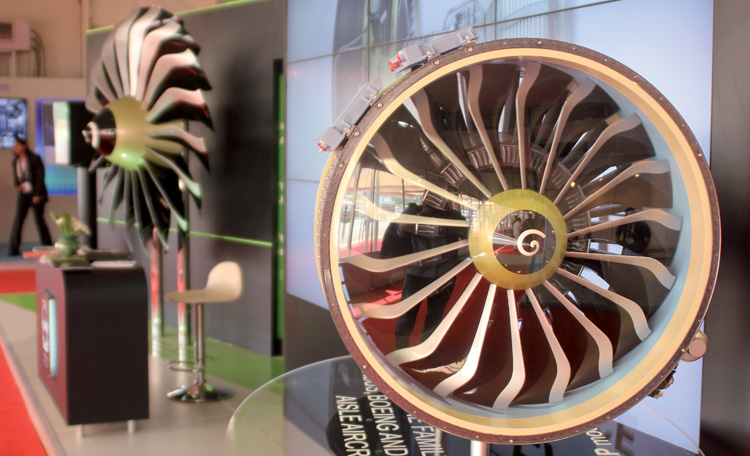- Prime Minister Narendra Modi inaugurates Aero India 2023 in Bengaluru; Releases Commemorative Stamp
- Defence Secretary meets delegations from Saudi Arabia, USA and Oman on the sidelines of Aero India 2023
- Foreign Ministers of 32 countries to attend Aero India 2023
- Embraer showcases the C-390 Millennium at Aero India 2023
‘The total firm CFM56 orders currently stand at more than 28,850 engines’
Interview with Jean-Paul Ebanga, President, CFM International

SP’s ShowNews (SP’s): Can you briefly outline the profile of CFM International and the range of its products?
Jean-Paul Ebanga (Ebanga): The CFM56 product line includes six engine models spanning the thrust range from 18,500 to 34,000 pounds (82 to 151 kN) thrust powering 30 commercial and military applications.
Commercial applications include Airbus A318, A319, A320, and A321 single-aisle aircraft, the long-range, four-engine A340-200 and -300, and the A318 Elite and A319 Corporate Jet; the Boeing Classic 737-300/-400/-500, and 737-600/-700/-800/-900/-900ER and Boeing Business Jet; and re-engined DC-8 Super 70 series aircraft.
The total firm CFM56 orders currently stand at more than 28,850 engines from more than 500 customers/operators, of which more than 23,000 have been delivered. These orders represent more than 55 per cent of the 100+ passenger aircraft ordered over the past decade. The in-service fleet, which includes more than 8,000 commercial and military aircraft, has logged more than 575 million flight hours as the most reliable engines in the air.
The CFM56-5B for the Airbus A320 family and CFM56-7 for the Boeing Next-Generation 737 incorporate most advanced technology while building on the inherent simplicity of CFM’s proven architecture and unequalled experience base. These engines are now the clear customer choice for powering single-aisle aircraft in the world marketplace. CFM was able to achieve this status by listening to customer requirements and developing the right balance of technology to meet them.
In 2008, CFM formally launched the LEAP engine family to power the next generation of single-aisle aircraft. This product line has been chosen for three applications and CFM has received orders for more than 34,000 engines.
SP’s: What is the market share that CFM International commands on the global scene?
Ebanga: The CFM56-7B is the sole power plant for the Boeing Next-Generation 737 family and nearly 6,100 airplanes have been ordered till date. In addition, the CFM56-5B is an option on the Airbus A320 family and has been selected to power nearly 3,100 airplanes, which represents nearly 60 per cent of the A320 family aircraft currently in service or on order.
SP’s: The Leap-X engine project was initiated three-and-a-half years ago. What is the state of its development and what are the features that make it unique?
Ebanga: LEAP engines incorporate revolutionary technologies never seen before in the single-aisle aircraft segment. The new engine combines advanced aerodynamic design techniques, lighter, more durable materials, and leadingedge environmental technologies, making it a major breakthrough in engine technology. As a result, the operators will achieve double-digit improvements in fuel burn, emissions, and noise while maintaining the benefits of CFM International’s legendary reliability and low maintenance costs.

In 2011, CFM completed testing of the advanced eCore Demonstrator 2, which includes a 10-stage compressor, lower emission TAPS 2 combustor, and two-stage high-pressure turbine, is the configuration for the LEAP engine schedule to enter service on the Airbus A320neo and COMAC C919 in 2016 and in 2017 on the new Boeing 737 MAX.
CFM has completed more than 150 test hours on the core, including conducting performance and operability tests such as low-speed stalls. The company also passed a major milestone recently with the completion of its internal Tollgate 3 process which, in effect, freezes the engine configuration. The next milestone will come in mid-2012 with the full engine design freeze.
The heavily instrumented hardware is tested approximately 2,000 different engine parameters. This unique test facility allows CFM to put the hardware through its paces by simulating both ground and altitude conditions over a much greater operating range than could be conducted with a full engine test. It allows engineers to see how the core behaves outside standard operating conditions at extremes the engine would never encounter in typical commercial airline service.
In early 2012, CFM has started the build up eCore Demo 3 to incorporate lessons learned on the two previous core tests, leading to the first full LEAP engine to test in 2013.
At the same time, testing of the advanced 3-D Woven Resin Transfer Molding (3-DW RTM) fan has yielded outstanding results. In May 2011, CFM completed a full-scale fan blade out rig test, simulating certification requirements for the proprietary 3-DW RTM technology. The company has also completed extensive full-scale component tests, including bird ingestion testing with the same very positive results. In August 2011, CFM completed endurance testing of the fan, with the hardware logging more than 5,000 cycles. The demanding test was designed to evaluate fan behaviour within a real thermal and vibratory environment. The preliminary results have been outstanding, meeting or exceeding all pre-test predictions.
In addition to fan tests, CFM has conducted extensive rig testing of its ultra-high efficiency LEAP low-pressure turbine with outstanding results. The rig, which included the full low-pressure turbine (LPT) and turbine rear frame, validated the technical innovations in the design, including the advanced three-dimensional designed airfoils and blade and vane alignment. Initial results confirmed very high efficiency levels and matched the results achieved in pre-test simulations. Testing has enabled CFM to assess acoustics and to validate corresponding LPT performance and airfoil mechanical behaviour in a real operating environment.

SP's: Who are the prospective customers for the Leap-X engine and the types of aircraft the new engine is expected to power?
Ebanga: The market for the LEAP engine family is future replacements of single-aisle aircraft, such as the Airbus A320 and Boeing 737 families. The LEAP-1A is offered at an option on the Airbus A320neo scheduled for commercial service in 2016 and CFM has garnered approximately 51 per cent of the new airplane orders announced to date. The LEAP-1B is the sole power plant for the Boeing 737 MAX family scheduled to enter commercial service in the 2017 time frame and Boeing has announced orders and commitments for just over 1,000 new aircraft. The LEAP-1C is the sole Western power plant for the COMAC C919 airplane and will enter service in 2016. Till date, COMAC has received orders for 235 airplanes.
SP’s: What steps are envisaged by CFM International beyond the Leap-X to cope with the formidable challenges on account of the progressively increasing environmental concerns the world over?
Ebanga: CFM has always had a policy of continually investing in technology to improve the in-service fleet. A great example of that is the introduction in 2011 of the CFM56-7BE on the Boeing 737 and the CFM56-5B Performance Improvement Program (PIP) on the Airbus A320. The CFM56-7BE, when combined with airplane improvements, improves fuel burn by two per cent. The CFM56-5B PIP provides added durability and improves fuel consumption by 0.5 per cent. In 2007, we introduced the new Tech Insertion configuration that improved fuel burn as well as reduced NOx emissions so that the CFM56-7B and CFM56-5B meet the ICAO CAEP/6 emissions standards that went into effect in 2008. This is the same philosophy with which the company is developing LEAP. This engine is bringing up to 15 per cent lower fuel consumption, which brings and equivalent reduction in carbon emissions. The advanced TAPS II (Twin-Annular, Pre-Swirl) combustor brings revolutionary technology to this market space and will reduce NOx emission by 50 per cent. At the same time, the engines noise footprint will be reduced by 75 per cent. This are all tremendous in-roads that will enter service in the next few years. Beyond that, the company will continue to refine its noise and emissions technologies for future programmes. In addition, all of the technology being developed for LEAP could serve as the basis for an advanced open rotor engine configuration that could bring significant improvements in fuel consumption. CFM parent companies GE and Snecma tested this technology in the 1980s and have continued to refine it. There are still challenges to be overcome with and open rotor design (including noise, certification, and airplane integration), so any potential entry into service would be beyond the year 2030, but CFM has made great strides in mitigating these challenges and will be ready with the right technology.
SP’s: What is the market share for CFM in the Asia-Pacific region and how do you perceive the prospects to be over the next two decades?
Ebanga: CFM has a very strong presence in Asia. Excluding China, there are approximately 1,235 CFM56-powered Airbus A32 and 737 airplane in service with more than 30 customers and an 520 still to be delivered. On top of that there have been more than 400 LEAP-powered aircraft ordered. Once you include China that adds more than 2,400 additional engines in service or on order. To put those numbers into perspective, CFM has the largest commercial fleet in the world with approximately 17,000 CFM56 engines currently in service; about 20 per cent of that fleet is in the Asia-Pacific region. Obviously, this region has been very important to us in the past and will continue to be so well into the future. The prospect for continued growth in Asia-Pacific is tremendous and CFM is proud to be a part of that growth.





